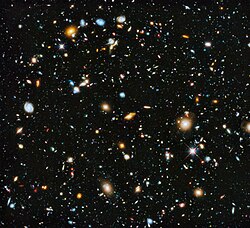The Universe

The Universe encompasses everything that exists, from the tiniest of atoms to the largest of galaxies. [1] In watching the night skies, astronomers can trace the signs of the Universe's beginning and learn about its evolution though studies of the stars, planets, nebulae, and galaxies. [2]
What is the Universe?
[edit | edit source]The Universe is the name astronomers give to the vast space which contains everything we know, from great clusters of galaxies to the tiniest of particles. [3] Professional astronomers have gathered clues about its evolution by capturing the light from galaxies many billions of light-years away. [4] [5] [6] [7] [8] [9] [10]
The Big Bang
[edit | edit source]The Universe is thought to have been born 13.7 billion years ago in a searing hot maelstrom known as the Big Bang. [11] One strong piece of evidence for this energetic beginning comes in the form of a ubiquitous source of microwave radiation appearing across the whole sky, known as the Cosmic Microwave Background (CMB). [12] As the Universe has stretched and expanded since the Big Bang it has also stretched the wavelength of the radiation emitted when it was very young. [13] So what was once higher-energy, shorter-wavelength radiation now appears as lower-energy, longer-wavelength microwaves. [14] Tiny fluctuations in the density of matter early on in the Universe acted like seeds around which matter began to clump, setting the scene for the formation of vast clusters of galaxies. [15] The fingerprints of these "seeds" can be seen stamped as minute variations in the Cosmic Microwave Background. [16] [17]
The first stars
[edit | edit source]The first stars are thought to have appeared around 200 million years after the Big Bang. They would have been truly gargantuan objects - perhaps 100 to 1,000 times the size of our sun, and made almost completely of hydrogen and helium. The stars we see today in our own galaxy and in nearby galaxies are totally different from this first generation of stars. This is because over billions of years, generations of stars created and dispersed new chemical elements as they lived and died, enriching the Universe with heavier elements. Carbon, oxygen, iron, and silicon were formed from nuclear fusion in the hot cores of the stars, and the very heaviest elements were forged by supernova explosions. As each star dies, it scatters new enriched star forming material across space. Without these successive generations of stars we simply would not be here today, as the ingredients to make us would not exist.
The first galaxies
[edit | edit source]Galaxies are huge collections of stars, and it is thought that the first galaxies began to form sometime around 500 million years after the Big Bang. These early groups would not have looked anything like "modern-day" galaxies such as the Milky Way. Observations made with orbiting telescopes such as the Hubble Space Telescope show that the earliest galaxies were small and irregularly shaped. Studies suggest that these early galaxies underwent vigorous star formation and that they were the building blocks of the galaxies we see today. Over time these smaller galaxies collided and merged together to form much larger galaxies, full of structure, like the ones near us in the Universe that we are able to observe today with amateur telescopes.
In recent years the number of galaxies that exist in the universe has been increased by a factor of ten, a remarkable revision, by examining deep field images by the Hubble Space Telescope. This, however, is misleading. These galaxies are the vast majority of galaxies formed in the early universe, and are so-called dwarf galaxies, similar to the companion galaxies of the Andromeda galaxy, M31 in the Messier catalog, and the Milky Way galaxy in the Local Group of galaxies.
This discovery, however, requires a slight modification of the Cosmological Principle, that has long been a governing principle in cosmology with which all cosmological models must be consistent. This states that, on a sufficiently large scale, the universe is homogeneous, that is, the same everywhere, and isotropic, the same in every direction as viewed from the Earth. This is equivalent to saying the universe is universally isotropic. That is, if every observer in the universe observes it to be isotropic, then it must also be homogeneous.
The detection of dwarf galaxies at the earliest epochs following galaxy formation, however, requires a condition be placed on the statement of homogeneity. We must now state that the universe is homogeneous when viewed at a common epoch. This, unfortunately, cannot be done because of the finite speed of light. We can only see distant objects at far earlier epochs. Yet the modified statement of homogeneity is still valid.
References
[edit | edit source]- ↑ https://www.theguardian.com/science/2019/may/12/100-years-on-eclipse-1919-picture-that-changed-universe-arthur-eddington-einstein-theory-gravity
- ↑ https://interestingengineering.com/bright-ancient-galaxies-shed-light-on-early-universe
- ↑ https://www.independent.co.uk/life-style/gadgets-and-tech/news/nasa-universe-beginning-light-space-telescope-stars-epoch-radiation-a8911561.html
- ↑ https://scitechdaily.com/astronomers-reveal-suppressed-star-formation-in-the-early-universe/
- ↑ https://dailygalaxy.com/2019/05/pop-goes-the-cosmos-mystery-of-the-universe-before-the-big-bang/
- ↑ https://cosmosmagazine.com/space/early-universe-much-brighter-than-predicted
- ↑ https://www.wired.com/story/a-bizarre-form-of-water-may-exist-all-over-the-universe/
- ↑ https://www.space.com/bright-galaxies-one-billions-years-old.html
- ↑ https://www.nbcnews.com/mach/science/new-hubble-space-telescope-photo-living-history-book-our-universe-ncna1004406
- ↑ http://blogs.discovermagazine.com/d-brief/2019/05/10/first-supernovas-iron-poor-stars/
- ↑ https://www.sciencetimes.com/articles/20512/20190420/what-was-going-on-before-the-big-bang.htm
- ↑ https://dailygalaxy.com/2019/05/pop-goes-the-cosmos-mystery-of-the-universe-before-the-big-bang/
- ↑ https://www.livescience.com/65254-what-happened-before-big-big.html
- ↑ https://www.space.com/universe-expanding-fast-new-physics.html
- ↑ https://www.thegreatcoursesdaily.com/earliest-molecule-after-big-bang-detected-in-space/
- ↑ https://www.techtimes.com/articles/243249/20190514/very-early-galaxies-shone-much-brighter-than-previous-expectations-says-researchers.htm
- ↑ https://www.axios.com/bezos-dreams-space-future-093b7042-3852-4a1a-8865-203bfd11873a.html
